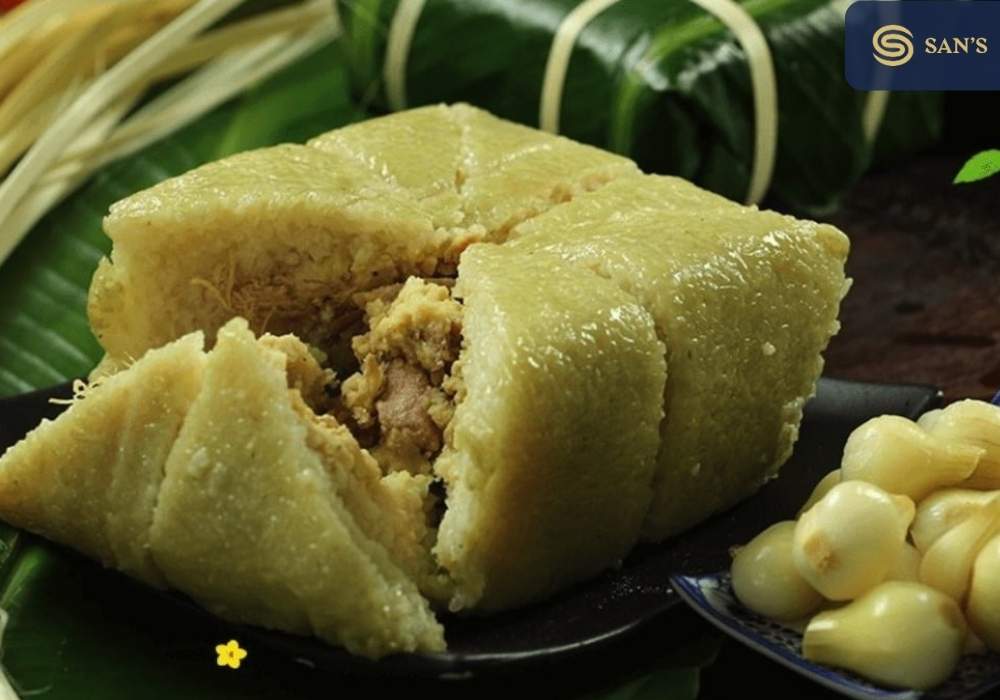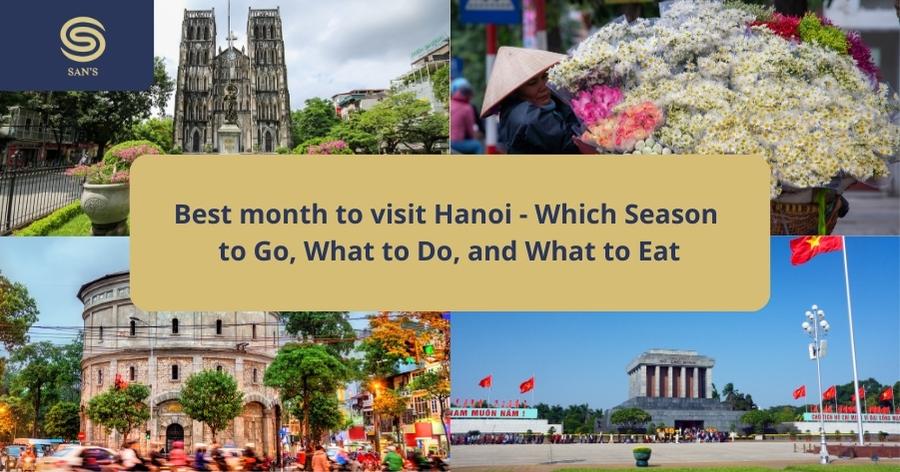Banh Chung stands as a cornerstone of Vietnamese Lunar New Year (Tet) celebrations, embodying rich cultural traditions and symbolism deeply rooted in Vietnam’s history. This iconic dish is not just a culinary delight but also a profound cultural artifact, representing the heart of Tet festivities. In this article, we explore the significance of Banh Chung, unraveling its historical origins, cultural meanings, and its revered status in Vietnamese society.

As a symbol of the earth, Banh Chung is traditionally made with glutinous rice, mung beans, and pork, all wrapped in green banana leaves. Its square shape and the green of the leaves signify respect for nature and the ancestors.
Through generations, the making and sharing of Banh Chung during Tet have become essential practices, reflecting the Vietnamese values of gratitude, togetherness, and reverence for heritage. Join us as we delve deeper into the story of Banh Chung, a dish that is much more than food—it’s a symbol of a nation’s spirit and a testament to the enduring legacy of its traditions.
The History and Origin of Banh Chung
The story of Banh Chung is steeped in legend and holds a significant place in Vietnamese folklore and history. This traditional dish’s origins trace back to the Hung Dynasty, over a thousand years ago, and are entwined with the tale of Lang Lieu, a prince who invented Banh Chung.
According to legend, the King challenged his sons to present a dish that would symbolize the respect for their ancestors during Tet. Lang Lieu, the youngest son, with limited means, created a simple yet meaningful dish using rice, beans, and pork, wrapped in green leaves.
His creation, Banh Chung, with its square shape symbolizing the Earth, was chosen for its sincerity and simplicity, and it has since become an integral part of Vietnamese Lunar New Year celebrations.
The legend of Lang Lieu and the inception of Banh Chung highlight its significance not just as a food item, but as a symbol of resourcefulness, humility, and connection to the land. Over the centuries, Banh Chung has transcended its mythological origins to become a staple of Tet festivities, embodying the spirit of the Vietnamese people and their deep-rooted reverence for their cultural heritage. This historical and cultural backdrop makes Banh Chung far more than just a traditional dish; it’s a cherished emblem of Vietnam’s rich and enduring history.

The Cultural Significance of Banh Chung
Understanding the symbolism of Banh Chung in Vietnamese culture reveals its deep-rooted significance. This traditional dish is not merely a food item; it’s a symbol steeped in meaning and tradition. Banh Chung is central to Tet, the Vietnamese Lunar New Year, representing more than just sustenance; it embodies the spirit of the past and the hope for the future.
In Vietnamese culture, Banh Chung is a symbol of the Earth, made evident by its square shape. It is traditionally prepared and enjoyed during Tet, reflecting the Vietnamese people’s respect for their ancestors and their land.
The process of making Banh Chung is a time-honored tradition, often involving multiple generations of a family, thereby reinforcing family bonds and passing down cultural values from elders to the younger members.
During Tet, Banh Chung takes on a role that transcends its culinary aspects. It is often placed on altars as an offering to ancestors, a practice that showcases reverence and gratitude. In family gatherings, sharing Banh Chung is a way of expressing hope for prosperity and well-being in the coming year.
This act of sharing not only fortifies familial ties but also ensures the continuity of a tradition that has been passed down through centuries.
The presence of Banh Chung in Tet celebrations is a vivid reminder of the rich cultural tapestry of Vietnam. It’s a dish that carries the essence of history, symbolizes unity, and represents the cyclical nature of life. In the heart of Vietnamese culture, Banh Chung is more than food; it’s a sacred tradition, a symbol of gratitude, and a testament to the enduring spirit of the Vietnamese people.

The Traditional Recipe of Banh Chung

The traditional recipe of Banh Chung is not just a culinary process but a ritual steeped in Vietnamese culture. This dish, integral to the Tet celebrations, is made with specific ingredients, each holding its own cultural symbolism.
Ingredients:
- Glutinous Rice: The base of Banh Chung, symbolizing nourishment and prosperity.
- Mung Beans: Used as a filling, representing purity and simplicity.
- Pork: Typically a fatty cut, symbolizing wealth and abundance.
- Green Banana Leaves: Used for wrapping, symbolizing the connection to the Earth and nature.
Walkthrough of the Recipe:
- Preparation of Ingredients: Soak the glutinous rice and mung beans in water for several hours. Marinate the pork in a mixture of salt, pepper, and shallots.
- Assembly: Lay out the banana leaves in a square mold. Place a layer of rice, then the mung beans, followed by the pork, and another layer of mung beans and rice. The layers represent the harmony of the heavens, Earth, and humanity.
- Wrapping and Tying: Carefully fold the banana leaves over the rice to create a tight, square package. The square shape of Banh Chung is significant, representing the Earth.
- Cooking: Traditionally, Banh Chung is boiled for several hours, which requires constant attention. The cooking process symbolizes the dedication and patience of the Vietnamese people.
- Serving: Once cooked and cooled, Banh Chung is cut into squares and served. It’s often enjoyed with pickled vegetables, enhancing the flavors and adding balance.
This traditional recipe of Banh Chung is more than a set of cooking instructions; it’s a cultural expression. Each step and ingredient in the making of Banh Chung is imbued with symbolism, reflecting the values, history, and traditions of Vietnam. The dish is a celebration of cultural identity and a homage to the past, making it a cherished and revered component of Tet festivities.
>>>Essential food of Tet in Vietnam
Preparation and Cooking Techniques for Banh Chung
Preparing and cooking Banh Chung is a process steeped in tradition, with each step carrying both cultural significance and culinary importance. Here’s a step-by-step guide that contrasts traditional methods with modern cooking techniques.
Traditional Method:
- Soaking: Begin by soaking glutinous rice and mung beans overnight in water. This softens them for cooking.
- Preparing the Leaves: Wash green banana leaves and trim them to size. The leaves are then briefly blanched in hot water to make them pliable and easier to fold.
- Filling Preparation: Marinate pork belly with salt, pepper, and finely chopped shallots. The pork symbolizes wealth and prosperity.
- Layering: On a piece of banana leaf, spread a layer of soaked rice, add a layer of mung beans, and then place the marinated pork in the center. Cover the pork with another layer of mung beans and top it off with more rice.
- Wrapping and Tying: Fold the banana leaves over to form a tight, square bundle. Traditionally, bamboo strips are used to tie and secure the bundle.
- Boiling: Submerge the wrapped Banh Chung in a large pot of water and boil for 6-12 hours. Regularly add water to keep the bundles submerged.
- Cooling and Pressing: Once cooked, remove the bundles and press them under a heavy weight to flatten and remove excess water.
Modern Techniques:
- Pressure Cooking: With modern kitchen appliances like pressure cookers, the cooking time of Banh Chung can be significantly reduced. The pressure cooker replicates the boiling process but in a fraction of the time.
- Vacuum Sealing: Instead of traditional banana leaves and bamboo ties, vacuum-sealed bags can be used. This modern method ensures that the Banh Chung is watertight and cooks evenly.
- Oven Cooking: Some modern recipes adapt the cooking process by baking Banh Chung in an oven. While not traditional, this method can produce a similar texture and flavor.
Whether sticking to traditional methods or adapting modern techniques, the preparation and cooking of Banh Chung are integral to its cultural and culinary significance. The process, requiring patience and care, is a testament to the dedication of preserving this important aspect of Vietnamese heritage.

FAQs about Banh Chung
- What is Banh Chung?
- Banh Chung is a traditional Vietnamese rice cake, primarily made during the Lunar New Year (Tet) celebrations. It’s made from glutinous rice, mung beans, pork, and wrapped in green banana leaves, typically in a square shape.
- What does Banh Chung symbolize in Vietnamese culture?
- Banh Chung is a symbol of the Earth, representing gratitude to ancestors and nature. It’s a significant part of Tet celebrations, embodying the Vietnamese spirit of tradition and family.
- How is Banh Chung traditionally cooked?
- Traditionally, Banh Chung is boiled for several hours. The cooking process is an essential part of the tradition, representing dedication and patience.
- Can Banh Chung be made with alternative ingredients for dietary restrictions?
- Yes, Banh Chung can be adapted for different dietary needs. For example, vegetarian versions can be made without pork, using mushrooms or tofu instead.
- How long can Banh Chung be stored and how should it be preserved?
- Banh Chung can typically be stored for several days at room temperature. For longer preservation, it can be refrigerated or even frozen, then reheated before serving.
- Is there a specific way to serve Banh Chung?
- Banh Chung is usually cut into square slices and can be served with pickled vegetables. It’s often enjoyed as a part of the Tet feast with family and friends.
- Are there modern variations of Banh Chung?
- Yes, there are modern takes on Banh Chung, such as using different fillings or cooking methods like baking or pressure cooking.
- How important is Banh Chung to the Tet celebration?
- Banh Chung is extremely important and almost indispensable in Tet celebrations. It’s a dish that brings families together and connects them with their cultural heritage.
- Can Banh Chung be found outside of Vietnam?
- Yes, Banh Chung can be found in Vietnamese communities worldwide, especially around Tet. Many Asian markets and Vietnamese restaurants offer it during the Lunar New Year season.
- What are the nutritional values of Banh Chung?
- Banh Chung is rich in carbohydrates and protein. The nutritional value can vary based on the ingredients used, particularly the amount and type of pork and the proportion of mung beans.





